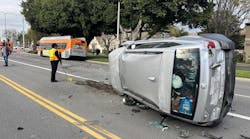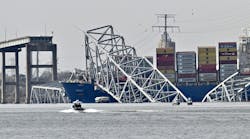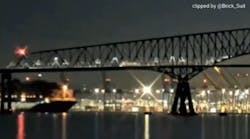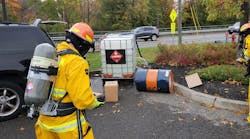Aug. 24--The Seattle Fire Department released its final report Friday investigating the response to the June drowning death of Washington State University graduate student Tesfaye Deboch in a Seattle hotel pool.
The eight-page incident report included a full description of the firefighters' response, followed by several notes and recommendations for improved response in the future.
Deboch, 27, drowned after becoming distressed while swimming laps in the deep end of the Quality Inn & Suites Seattle Center pool around 5:30 p.m. June 30. Ten Seattle firefighters were dispatched to the scene following a 911 call from a hotel employee who, misunderstanding one of Deboch's friends, reported a child was drowning.
Deboch and several of his friends and colleagues were in Seattle for an academic conference.
The Fire Alarm Center also dispatched a water rescue dive team, without the boat resources generally used in open-water rescues, shortly after. Seattle Fire Department Chief Gregory Dean said the dive team consists of four people and is responsible for all water search and rescue calls in the area.
The first group of firefighters responded to the hotel in just under two-and-a-half minutes, but they were unaware a water rescue team had also been dispatched because the two groups were on different radio channels.
According to the report, when firefighters entered the pool area, they saw five people looking in the deep end and one hotel maintenance staff member sweeping the pool with a cleaning pole. A life ring was floating on the surface.
Another person was swimming in the pool and diving to the bottom, trying to locate Deboch. Firefighters also began to search the pool, and while the water was hazy, firefighters were able to clearly see the bottom and the sides of the pool's deep end.
They could not see anyone at the bottom, the report said.
More firefighters arrived on scene, and when they asked the people near the pool what had happened, they learned it was not a child who was drowning, but Deboch, who was at least 6 feet tall. They also learned no one had actually seen him sink below the surface. The report stated the people were unsure of Deboch's whereabouts, although they thought he was in the east end of the kidney-shaped pool, which was about 8.5 feet deep.
Firefighters discussed whether to have one firefighter get in the pool and search, but decided against it since a victim could not be located and firefighters believed they could see the entire pool from the surface. The civilian swimmer said he had not been able to see or feel Deboch on the bottom of the pool and later left the scene.
A firefighter and the hotel employee conducted another grid search of the pool using cleaning and rescue hook poles. When the search was unsuccessful, one of the responding officers cancelled all other incoming units around 5:40 p.m. Because he was using a different radio channel, he was unaware the cancellation also included the water rescue team.
"They determined, based on what they were seeing as well as the actions they took, that they did not need additional resources," Dean said.
Firefighters on scene continued sweeping the pool and looking from different angles, while two Seattle Police officers arrived and began talking to Deboch's friends. The report stated that after being unable to locate Deboch and hearing no one had witnessed him sink, firefighters began to think Deboch had left the pool area through a door opposite the hotel lobby, where his friend had gone for help.
Deboch's clothing and other belongings were still on a chair near the pool, though firefighters did not see them, the report said.
One group of firefighters then searched Deboch's hotel room on the third floor, where they noticed his cellphone was plugged in, and also searched the second- and first-floor hallways, but found no sign of him. Another group scanned the pool using a thermal imaging camera, but also found nothing.
The report stated the thermal imaging camera could only pick up surface temperatures, and the firefighters knew this but thought it might still provide additional information beyond what they could see with their own eyes.
At that point, all of the firefighters were confident Deboch was no longer on the premises and turned the scene over to police before leaving the scene at 5:52 p.m., around 17 minutes after they had arrived.
According to the report, after Seattle Police officers had cleared the scene sometime after 6 p.m., hotel patrons continued to swim in the pool but noticed the water was becoming increasingly murky and alerted hotel staff.
A staff member went to check on the pool, and Deboch's friends had returned to search the water again after being unable to find him elsewhere. A nearby hotel guest, who was an off-duty firefighter and had heard about the earlier possible drowning, grabbed a cleaning pole and helped in the renewed search effort.
He was unable to see the drain or the bottom of the pool in the deep end, but he felt the pole touch something. He thought suction was preventing him from moving it and asked the hotel employee to shut off the pool's intake.
At 8:12 p.m., Deboch's body was pulled out of the pool with a rescue hook, and 911 was called for a second time.
Firefighters arrived two minutes later and conducted CPR for 20 minutes before pronouncing Deboch dead at 8:35 p.m. They also noticed the hotel pool water was murkier than it had been earlier that evening.
Observations and recommendations
At the end of the eight-page SFD incident report is a list of five observations and several recommendations regarding the initial response to the drowning.
The first observation had to do with the FAC dispatching the water rescue team for a pool drowning. The department's current water rescue model is designed for open-water rescue, and the small dive team is responsible for any search and rescue calls that involve any of Seattle's 200 miles of shoreline and pools. The team also cannot arrive on scene as quickly as other firefighters.
Based on the response model, dispatchers estimated if the water rescue team's services had not been canceled, they would have arrived at the hotel and conducted a rescue in about 15 minutes. The report said if any of the first-responding firefighters had been rescue swimmer qualified, they would have been in the pool 30 seconds after arrival.
Dean said Seattle firefighters are not required to have basic swimming skills, and current training does not teach firefighters what to do should they choose to enter the water in a scenario similar to Deboch's drowning.
He said the firefighters on scene were also not trained to understand the challenges of searching for a drowning victim from the water's surface. The report cited a 2007 study in the International Lifesaving Federation Conference Paper, which states that different factors can impair a person's ability to see another person at the bottom of a pool. These factors include surface turbulence, water depth and clarity, as well as lighting, shadows and reflections.
The report stated that combined, these factors can "make it difficult to see a victim on the bottom of a pool even if visual cues indicate the bottom can be plainly seen."
Dean said the fire department will immediately begin including this information during training and plans to send out the full incident report to every station for learning purposes. He said the department is also considering increasing the amount of rescue swimming training it provides.
Dean said the responding firefighters acted appropriately and exhausted every option they were trained to use. Because of that, he said, there has been no internal discipline as a result of the incident.
"This was a tragic accident ... our firefighters were taking steps to resolve this. There will not be discipline based on the fact that they were unsuccessful," he said.
The pool at the Quality Inn & Suites was closed July 10 after an inspection by Public Health-Seattle and King County officials turned up 10 safety violations, three of which were serious enough to require closure.
James Apa, communications manager at Public Health-Seattle and King County, said the pool has not reopened. He said there are several issues to address before the pool can be reopened safely and that the hotel has not contacted Public Health to review the issues.
Meredith Metsker can be reached at (208) 883-4628, or by email to [email protected]. Follow her on Twitter @MeredithMetsker.
Copyright 2013 - Moscow-Pullman Daily News, Moscow, Idaho





